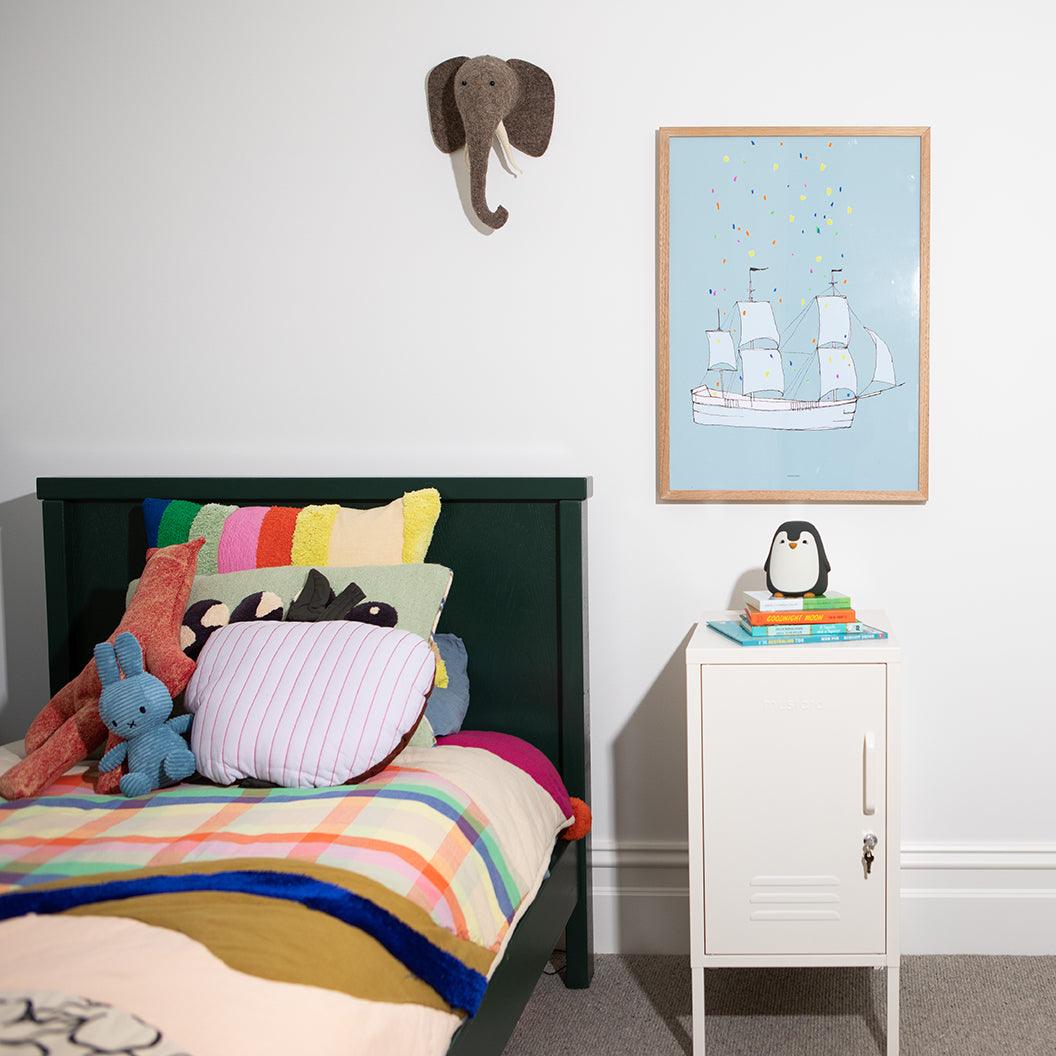When the time is right
Kids of any age can share a room, but the time is best when the youngest is sleeping through the night, so no one's sleep is disturbed. It also should be a time when both share the same sleep routine and aids, or, aren't disturbed by the others. Your elder might not mind a night light, but if one likes white noise and the other doesn't you might have problems. If you've used the same sleep aids with your children, this shouldn't be a problem. It's also important that sharing is a norm for them before they start sharing a room together so that it's not seen as a negative. Sharing bath time, chores and toys is a great start. If that's going well, the rooms will be easier.
Think a little more longterm
A big part of designing a room for kids to share is not just how practical and functional you can make it now, but how long is it going to last and how can you change and adapt it going forward. The boys have been sharing for around 4 years now and will probably for another 4 or more, so I need to keep in mind that whatever we put in place now has to be easily (enough) changed or rearranged again later. Because I decided to build the beds into the wall, it will take a bit of effort to pull one out and convert the area into a desk for studying when have need for it, but I knew that going into the makeover. So before you find Pinterest-worthy inspiration, think ahead 5 to10 years and imagine what the space will need to look like then too, so can spend money wisely and find ways to make furniture and the room work harder. A cot that converts to a toddler bed that coverts to a single bed like the Leander Cot is a great example of life with a long lifespan.
Create personal spaces for each
Every kid needs privacy sometimes, but introverts especially crave it because they get energy from being alone, it is totally possible to create them their own space in a shared room. A bed canopy, a table and chair that's just for them, or a higher shelf, or for older kids, a special box that's just for their own things. Generally, designate special areas for each child’s belongings: hooks, a bedside table or a box that's just for them.
Bunk beds verse single beds
This is a big one! I spent hours (days even?!) researching the pros and cons of bunk beds. When you have kids sharing a room, it’s an obvious choice, of course! But as with all furniture decisions, there is plenty to think about, so lets break it down:
Single beds:
PROS:
- Easier to make the beds (and encouraging the kids to do it)
- Makes moving one into another room or selling one in the future a lot easier
- Less assembly and easier to move around
- Safe
CONS:
- Takes up a lot more space in a room
Bunk beds:
PROS:
- Excellent space saver
- Can be a lot of fun for siblings and creates some sleep privacy
- Can be cost effective
- Potential to find bunk beds that can be pulled apart into singles later
CONS:
- Harder to change the sheets on the top bunk (especially if a kid gets sick in the night)
- Height safety depending on the age of kids and structural safety needs to be considered
- Can create arguments over who sleeps where
The pieces worth investing in
When it comes to what to spend your money on, start with quality beds in whatever style works best for you, then invest in pieces that will last.
Sturdy drawers and wardrobes If built-ins aren’t possible, look for drawers and wardrobes that can be attached to walls - this is a key component of keeping bedrooms safe. When looking at this kind of furniture, be sure to check that the drawers and doors are easy to open and shut for little hands, and also that the storage is nice and deep. Shallow drawers will fill up fast and become frustrating, quickly.
Toy and book storage Don’t underestimate the power of fantastic storage. The better organised this is, the more time you’ll save in the future. And this is the important bit: the kids need to be able to access it easily. I’ve made the mistake of trying storage solutions that were too tricked-up for the kids to use. Hard to handle lids with clips for example, get tricky for children’s hands and you know what that means? Less of them packing things away! So keep storage simple enough for them to use so they can get in the habit of picking up and putting things away.
Making it kid-friendly Big baskets with kids, cub storage with pull our boxes and shelves are all great options. Colour coding bookshelves and drawers and using big labels with illustrations as well as words, will help little ones take ownership of their things and encourage them to tidy up too.
If things aren't immediately perfect, backyourself
Expect a transition period of three to six weeks to adjust to rooming together, and be patient.














-v1660888487183.jpg?4357x6535)







